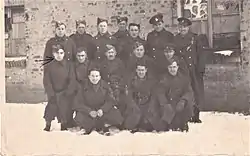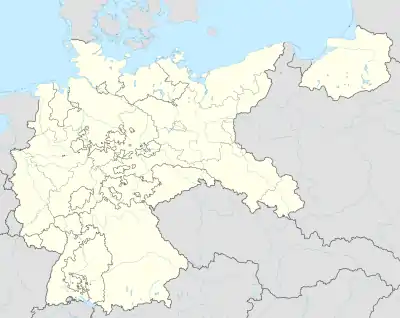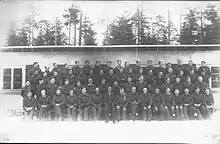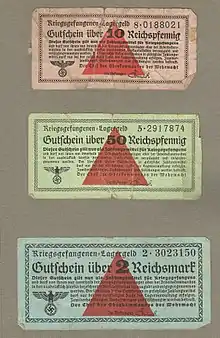Stalag VIII-B
Stalag VIII-B Lamsdorf was a German Army prisoner of war camp, later renumbered Stalag-344, located near the village of Lamsdorf (now Łambinowice) in Silesia. The camp initially occupied barracks built to house British and French prisoners in World War I. At this same location there had been a prisoner camp during the Franco-Prussian War of 1870-71.
| Stalag VIII-B / Stalag 344 / Stalag Luft VIII-B | |
|---|---|
| Lamsdorf, Germany (today Łambinowice, Poland) | |
 Prisoners in Stalag VIII-B | |
 Stalag VIII-B / Stalag 344 / Stalag Luft VIII-B  Stalag VIII-B / Stalag 344 / Stalag Luft VIII-B | |
| Coordinates | 50.53884°N 17.55872°E |
| Type | Prisoner-of-war camp |
| Site information | |
| Controlled by | |
| Site history | |
| In use | 1939–1945 |
| Garrison information | |
| Occupants | Allied PoW |
Timeline
In the 1860s, the Prussian Army established a training area for artillery at a wooded area near Lamsdorf, a small village connected by rail to Opole and Nysa. During the Franco-Prussian War, a camp for French prisoners of war was established here, which housed some 3000 French POW's. During the First World War, a much larger POW camp was established here with some 90,000 soldiers of various nationalities interned here. After the treaty of Versailles, the camp was closed down.
It was reopened in 1939 to house Polish prisoners from the German invasion of Poland, which started World War II in September 1939. Later during the war, approximately 100,000 prisoners from Australia, Belgium, British India, British Palestine, Canada, France, Greece, Italy, the Netherlands, New Zealand, Poland, South Africa, the Soviet Union, the United Kingdom, the Isle of Man, the United States and Yugoslavia passed through this camp. In 1941 a separate camp, Stalag VIII-F was set up close by to house the Soviet prisoners.
In 1943, the Lamsdorf camp was split up, and many of the prisoners (and Arbeitskommando) were transferred to two new base camps Stalag VIII-C Sagan (modern Żagań) and Stalag VIII-D Teschen (modern Český Těšín). The base camp at Lamsdorf was renumbered Stalag 344.
The Soviet Army reached the camp on 17 March 1945.
In 1945-1946, the Lamsdorf camp was used by the Polish Ministry of Public Security to house some 8000-9000 Germans, both prisoners of war and civilians. Polish army personnel being repatriated from POW camps were also processed through Lamsdorf and sometimes held there as prisoners for several months. Some were later released, others sent to Gulags in Siberia. About 1000-1500 German prisoners died in the camp due to malnutrition, lack of medicine and acts of violence and terror by the guards. Camp commander Czesław Gęborski was later put on trial for his role in running the camp.
Stalag Luft VIII-B
By 1943, the famous camp for Allied flight personnel in Sagan - Stalag Luft III - had become so overcrowded that about 1,000, mostly non-commissioned flight personnel, were transferred to Lamsdorf. A part of Stalag VIII-B was separated by building new barbed-wire fences, designated Stalag Luft VIII-B. Thus a camp within a camp was created. However all food was provided from kitchens operated by army personnel in the camp proper.
Medical facilities

The hospital facilities at Stalag VIII-B were among the best in all Stalags. The so-called Lazarett was set up on a separate site with eleven concrete buildings. Six of them were self-contained wards, each with space for about 100 patients. The others served as treatment blocks with operating theaters, X-ray and laboratory facilities, as well as kitchens, a morgue, and accommodations for the medical staff.
The lazarett was headed by a German officer with the title Oberst Arzt ("Colonel Doctor"), but the staff was made up entirely of prisoners. They included general physicians and surgeons, even a neurosurgeon, psychiatrist, anesthesiologist and radiologist.
Evacuation and repatriation

In January 1945, as the Soviet armies resumed their offensive and advanced into Germany, many of the prisoners were marched westward in groups of 200 to 300 in the so-called Death March. Some died from the bitter cold and exhaustion. The lucky ones got far enough to the west to be liberated by the American army. The unlucky ones got liberated by the Soviets, who instead of turning them over quickly to the western allies, held them as virtual hostages for several more months. Many of them were finally repatriated towards the end of 1945 through the port of Odessa on the Black Sea.
Arbeitskommandos

There were more than 700 subsidiary Arbeitskommandos (working parties outside the main camp). In the second issue of The Clarion (the camp magazine) in February 1943, the RC Chaplain Father John Berry says that "...there are about 600 Working Parties and ..... you will be able to guess why so many of you will have not yet had a visit". Arbeitskommandos were set up to house lower ranks that were working in the coal mines, quarries, factories and on railways. Among them were:
- Schalkendorf in the Kreis (Area of) Opole - Siołkowice near Opole - POW(50/80) Work to strengthen the embankments on the Odra River.
- Stauwerder Bezirk - Peiskretscham
(Dzierżno district - Pyskowice)
- E1 Laband - Łabędy - (Lager I - Train station) - (1st work - "SIEMENS-BAU-UNION"),next - Ironworks"Laband"
- POW(221) Huta "Łabędy" Gliwice
- E2 Cosel - Koźle :POW(102)
- E3 Blechammer - Blachownia Śląska (Kędzierzyn-Koźle)
"Oberschlesische Hydrierwerke A.G."
- E8 Krappitz Krapkowice paper mill Natronzellstoff-und Papierfabriken A.G.,
Werk Krappitz-Zellstof u.Papierfabrik
- POW(102);Fabryka Celulozy i Papieru Natronowego w Krapkowicach
- E17 Opole cement factory
- E22 Gleiwitz Oehrigen - "Sosnitza" coal mine :POW(290); Gliwice - kopalnia "Sośnica"
(Stalag VIII-B Teschen)
- E25 Rauschwalde, Kreis Falkenberg (Raschwitz) ; Radoszowice
- E27 coal mine
- E30 Oppeln III (Sakrau) - Opole Zakrzów - "Oppeln III Portland-Zementwerke"; Opole - cementownia"ODRA"
- E31 Pechhütte,Schelitz(Chrzelitz), Wiesengrund - Kreis Neustadt O.S.; Smolarnia,Chrzelice,Łącznik(Lonschnik)- is a villages in the Krapkowice County, Opole Voivodeship
- E42 Rothfest - Rudawa (Bodzanów) near Ziegenhals (Głuchołazy) - Paper Mill - "Rothfest Papierfabrik dr.Albert Spenner GmbH"; Głuchołaskie Zakłady Papiernicze Zakład Rudawa
- E51 Klausberg (Mikultschütz),
coal mine"Abwehrgrube"Hindenburg POW(533) kopalnia"Mikulczyce" - Zabrze Mikulczyce (Stalag VIII-B Teschen)
- E55 Hindenburg-Borsig;
Zabrze-Biskupice,coal mine "Hedwigs-Wunschgrube" Borsig-Koks-Werke ; kopalnia "Pstrowski" Zabrze - Biskupice
- E62 Gleiwitz-Steigern (Ellguth-Zabrze) :POW(23); Gliwice-Sztygarów (Ligota Zabrska)
(Stalag VIII-B Teschen)
- E71 Neurode - Nowa Ruda - "Rubengrube" coal mine,:POW building gym "Turnhale" and barracks - Kunzendorf (Drogosław) near Neurode;kopalnia "Piast" - Nowa Ruda koło Kłodzka
- E72 Beuthen "Beuthengrube"
coal mine :POW(171-204-600); Bytom kopalnia "Bytom"
- E74 Althaus (Dometzko) - Domecko ,Gmina Komprachcice, powiat Opole,Voivodeship Opole
- E75 Knurów coal mine"Knurów"
- POW(262);1944-3 prisoners were shot while escaping
- E88 Hohenlohehütte - Wełnowiec - (district in Katowice-1951)Coal mine "Król"(König)mine east shaft - "Agneschaft"- colony Agneshütte
- POW(177);Szyb "Agnieszka" - wschodni szyb kopalni "Król"("Król-Święty Jacek")w kolonii Agnieszka; ("Königsgrube" - Königshütte / kopalnia "Prezydent" - Chorzów)
- E90 Erlenbusch (Nieder Tannhausen) - Olszyniec.
In the years 1944-1945, there was a branch of the Groß-Rosen concentration camp in the village Erlenbusch.
- E93 Sakrau, limestone quarry - Zakrzów k/Krapkowice - kamieniołom wapienny
- E94 "Emilienhoff" Vorwerk (pol.Malnia;ger.Mallnie/Odergrund)POW:work limestone quarry, "Bata" shoe factory and construction Reichsautobahn motorway ;Ex-property Malnia "Emilienhof" belonged to Graf von Sponeck.Folwark Malnia "Emilienhoff" k/Gogolin - kamieniołom wapienny. Praca:Fabryka butów "BATA", budowa autostrady Reichsautobahn. Ex-folwark Grafa Von Sponeck.
- E110 Stauwerder Bezirk - Peiskretscham ; (Dzierżno district Pyskowice) Exploitation of aggregates :POW(39)
(Stalag VIII-B Teschen)
- E114 Gross Kunzendorf, stone quarry and factory
- E115 Burgwasser (Dobrau)-Dobra near Krapkowice;3 POW escape - 18 VIII 1941
- E119 Mankendorf, saw mill[1]
- E126 Oppeln - Halbendorf ; Opole - Półwieś
- E131 Gogollin - Tiefbau Pollok - stone quarry;Gogolin - kamieniołom
wapienny
- E138 Ratibor, steel works - "Schondorff Hegenscheidt Werke Ratibor":POW(30) Accommodation in a restaurant; Racibórz
- E149 Buchenlust - forestry work
- POW(68) - Rachowice - gospodarka leśna
- E150 Oderfest - Przywory (Przywor)
- E151 Hindenburg - "Concordia-grube"; Zabrze - Maciejów.
"Westschacht Concordiagrube" 1941/42 Gewerkschaft Castellengo-Abwehr A.G.~ Vereinigte Oberschlesische Huttenwerke AG Gleiwitz Werk Donnersmarckhutte;Zabrze - Maciejów - kopalnia " Ludwik-Concordia" - "Szyb Maciej".
- E152 Waldenstein (Goradze) - Górażdże near Gogolin - limestone quarry
- E154 Gollendorf hamlet - Nieder Pomsdorf near Patschkau; przysiółek Golina - Pomianów Dolny koło Paczkowa.
- E155 Cosel Oderhafen - Siemens Papier- und Zellstofwerke Feldmuhle AG in Cosel – Oderhafen O/S;Koźle-Port - Zakłady Papieru i Celulozy (Kędzierzyn-Koźle)
- E159 Domstadtl, quarry
- E162 Oderthal (Deschowitz) -
"Schaffgotsch Benzin Werke GmbH Odertal":POW-near building ODERTAL-BAHNHOF-HOTEL; Zdzieszowice
- E171 Setzdorf III - Vápenná :POW(29) Neugebauer limestone quarry
- E172 Setzdorf I - Vápenná :POW(20) Alojs Rösner quarry
- E173 Setzdorf II - Vápenná :POW(60)quarry Anton Latzel
- E183 Bernstadt - Bierutów
- POW (probably - sugar factory - Zuckerfabrik Bernstadt)
- E191 Stöblau - Steblów
- E195 Roding (Kopaline) - Kopalina
settlement in the administrative district of Gmina Strzeleczki, Krapkowice County, Opole Voivodeship; Kopalina przysiółek wsi Ścigów.
- E196 Opoleonoora - cement factory
- E198 Schlegel (Słupiec) near Neurode (Nowa Ruda) near Glatz (Kłodzko) coal mine - "Johann Baptista-Grube"; Kopalnia węgla kamiennego Słupiec (Jan Baptysta/Jan - Nowa Ruda)koło Nowej Rudy okolica Kłodzka.
- E199 Waldenburg - Wałbrzych - "Weißstein Glashüttenwerk Weihrauch & Zimmer"Hochwaldstr.;
Wałbrzych - Biały Kamień,ul.Piasta - dawna huta szkła
- E201 Dirschel - Dzierżysław - Gypsum mine;kopalnia gipsu "Czernica-Dzierżysław“near
Kietrz,Głubczyce County, Opole Voivodeship
- E203 Opole, cement works
- E209 Beuthen Bobrek - Bytom
coal mine "Gräfin Johanna Schacht",
- POW(111/141)Bytom Bobrek - szyb"Józef" kopalni "Bobrek".
(Stalag VIII-B Teschen)
- E211 Trebnitz - POW railway ; Trzebnica - kolej
- E218 Flössingen - Pławniowice - POW(17) Prisoners worked in the estate of Count von Ballestrem
- E234 Tonhain (Tschirne) Czerna, Kreis Bunzlau,POW:brickyard - cegielnia Czerna - powiat Bolesławiec
- E243 Breslau gasworks - Städtische Gasanstalt Dürrgoy; Wrocław - Tarnogaj - gazownia miejska
- E247 Leobschütz - Głubczyce
- E253 Neukirch - Polska Cerekiew
- E255 Hartenau - Twardawa near Kędzierzyn-Koźle :sawmill - tartak
- E256 Zuckmantel Zlaté Hory, Jeseník District,Olomouc Region, Czech Republic
- E265 Grafenweiler Kolonowskie - "Kartonagenfabrik Colonnowska Gmb.H" w Kolonowskiem
- E267 Bauerwitz Zuckerfabrik - Baborów (daw. Baworów) sugar beet factory:POW(64); cukrownia Baborów - powiat głubczycki województwo opolskie
- E268 Moschendorf bei Goldberg - (Stalag VIII-A Görlitz); Muszczyna koło Złotoryi
- E276 Ottmachau, sugar beet factory - Otmuchów
- E283 Ratibor, sugar mill - Racibórz - cukrownia
- E287 Neukirch - Polska Cerekiew
- E288 Bauerwitz - Baborów (daw. Baworów)- Głubczyce County, Opole Voivodeship
- E291 Stephansdorf - Radzikowice
,Gmina Nysa,Nysa County, Opole Voivodeship
- E294 Stephansdorf - Radzikowice
- sugar beet factory; cukrownia. ,Gmina Nysa,Nysa County, Opole Voivodeship
- E303 Petersweiler [Pietrzykowice]- sugar beet factory;cukrownia
- E324 Gross Dubrnsko - Dębieńsko (Czerwionka-Leszczyny)
- POW(25)worked in private estates
(Stalag VIII-B Teschen)
- E330 Thule - Tuły ,Gmina Lasowice Wielkie,Kluczbork County, Opole Voivodeship
- E332 Rudgershagen - Rudziniec - POW(37)worked in private estates; Rudziniec Gliwicki
(Stalag VIII-B Teschen)
- E341 Buchenhöh (Zyrowa)- Żyrowa - Gmina Zdzieszowice, Krapkowice County, Opole Voivodeship :POW(25)
- E354 Jägerndorf, saw mill & timber goods factory
- E363 Ratiborhammer - Kuźnia Raciborska -1940-43Eng POW(80) ,"Schondorff-Hegenscheidt Werke" factory making aircraft parts; "RAFAMET" - Kuźnia Raciborska
- E364 Buchelsdorf - saw mill; Niemysłowice - tartak
- E365 Gross Strehlitz - Strzelce Opolskie - lime quarry :POW(150) kamieniołom:wapnia
- E371 Ziegenhals - Głuchołazy - Möbelfabrik "Pantke und Scheitza"
- E373 Blaschke - Vlaské, Czech Republic - sawmill
- E389 Rudgershagen - Rudziniec -
sawmill "Sägewerk":POW(15)tartak - Rudziniec Gliwicki (Stalag VIII-B Teschen)
- E393 Mittel-Lazisk:POW(158)
Power Station;Łaziska Średnie - Elektrownia;(Stalag VIII-B Teschen)
- E399 Sudetenland Cardboard Factory - Fabryka Kartonów
- E406 Seifersdorf, brickyard
- E411 Beuthen Schönberg -
coal mine "Hohenzollerngrube"
- POW(38),(Stalag VIII-B Teschen)
Bytom kopalnia "Szombierki"
- E414 Hohenbirken bei Ratibor - saw mill "LUKASINA";Brzezie nad Odrą (ob.dzielnica Raciborza) - tartak "LUKASINA",(LUKASYNA; de.-Lukasine) ~ Dębicz .
- E415 Hohenbirken bei Ratibor - tile factory ; Brzezie nad Odrą (ob.dzielnica Raciborza) Lukasyna ~ Dębicz
- E419 Oppeln Groschowitz - cement factory - concern "Schlesiche Portland Zement-Industrie A.G. Oppeln" -
change in 1941 taken over by the concern "Verenigte Ost und Mitteldeutsche Zement Aktiengesellschaft" ; Opole Groszowice cementownia.
- E428 Derschau - Suchy Bór - sawmill 2nd owner Berthold Winkler ;POW(34) tartak Suchy Bór,gmina Chrząstowice,powiat Opole
- E431 Unter-Weckelsdorf - Dolní Teplice
- E446 Zuckmantel (ZLATÉ HORY) POW(11) working on "Śliweczka" sawmill. Accommodation in the sawmill area.
- E456 Kalkau Kałków - Fortifications works :POW(60); Kałków - prace fortyfikacyjne.
- E460 building railway bridge
- E478 Tost O/S - Toszek - sawmill
- POW(20)tartak.
Oflag VIII-D Tost;Oflag 6& Ilag A/H POW(1249-military&civilians), buildings hospital - Provinzial–Heil- und Pflegeanstalt (Anstalt); Toszek - szpital psychiatryczny
- E479 Tarnowitz railway:POW(207)
- E484 Neisse , labouring - Nysa
- E486 Neisse, labouring - Nysa
- E490 Beuthen railway building - (Stalag VIII-B Teschen):POW(32), Bytom
- E494 Gleiwitz Ost -railway transport :POW(52) transport kolejowy,(Stalag VIII-B Teschen);
Gliwice Wschodnie (Sośnica)
- E508 Laurahütte (Siemianowitz) -
Siemianowice Śląskie - Hütte "Laura" Berghütte Königs- und Bismarckhütte AG Rheinmetall-Borsig :POW work production of anti-aircraft artillery in the Laura mill; Siemianowice Śląskie - huta "JEDNOŚĆ".
- E532 Stephansdorf - Radzikowice
,Gmina Nysa,Nysa County, Opole Voivodeship
- E535 SOSNOWITZ West - "MILWITZGRUBE" coal mine :POW(~500) 6 barracks;
SOSNOWIEC"MILOWICE"kopalnia
- E538 SOSNOWITZ - Sielz- Sielec -
coal mine "GRAF RENARD Grube", POW(526)barracks on Butchery street (ul.Rzeźnicza) - Sosnowiec kopalnia "HRABIA RENARD" (after 1945 "SOSNOWIEC"),(Stalag VIII-B Teschen)
- E542 Föhrengrund ub Gleiwitz
(Latscha); Łącza - województwo śląskie,powiat gliwicki,gmina Rudziniec
- E543 Dombrowa - coal mine "PARIS"
(PARIS Grube)POW(423)KOSZELEW- 8 barracks on coal mine "KOSZELEW" area of the wooden square.
Dąbrowa Górnicza kopalnia "Paryż" baraki jeńców na terenie placu drzewnego kopalni "KOSZELEW". (Stalag VIII-B Teschen)
- E550 Hohenbirken bei Ratibor - tannery ; Brzezie nad Odrą (ob.dzielnica Raciborza) garbarnia
(LUKASINA - Lukasyna) ~ Dębicz
- E552 Hindenburg Philipstr.(Zabrze)POW(40)Firma Karla Antona
- E560 Turawa - Sawmill - Graf von Garnier - tartak hrabiego Garniera
- E561 Jaworzno - Tarnowitz - railway depot loading & unloading trains; Jaworzno - Tarnowskie Góry
- E562 Libiaz - coal mine"Johanna"
("Gute Hoffnung"):POW(250) Libiąż kopalnia "Janina"
- E563 Bory Jeleń Jaworzno -
coal mine "Bory"("Robertgrube")
- POW(157); Jaworzno Bory - kopalnia "Sobieski"
- E565 Siersza Wodna (Trebing)
coal mine "Arthurgrube":POW(120); Krze(Trzebinia) kopalnia "Artur".
- E571 Gruden (district) Oppeln - (Staatsforst Gruden - Grudschütz) forestry department - Opole-Grudzice - Nadleśnictwo Grudzice
- E578 Peiskretscham, Kreis Gleiwitz - Pyskowice - (k/Gliwice)
- E579 Niwka (stalag called "Pawiak") 8-barracks POW(600/1000)
coal mine"Modrowgrube" Sosnowitz ("Theodor Körner" Preussag); kopalnia"MODRZEJÓW"Sosnowiec
- E580 Czeladz -"SATURN" coal mine,(8 barracks on CarbonStreet) POW(352)British paratroopers;
Czeladź ulica Węglowa - Jeńcy: Brytyjscy Spadochroniarze; (Stalag VIII-B Teschen)
- E585 Jagerndorf, brickyard
- E586 Kazimierz - "Juliusgrube" -
coal mine (SOSNOWITZ):POW in School building - Ligonia street 3a - kopalnia "Kazimierz-Juliusz" (district Porąbka - JULIUSZ)SOSNOWIEC.Kwatera jeńców: szkoła podstawowa nr.35 im.Armii Krajowej, ul.Ligonia 3a - SOSNOWIEC Pekin-Porąbka
- E587 Czeladz (Piaski - district) coal mine "CZELADŹ" kopalnia - Czeladź Piaski,(Stalag VIII-B Teschen)
- E593 Beuthen Schönberg -
coal mine "Hohenzollerngrube" : POW(416)Bytom kopalnia "Szombierki" - (Stalag VIII-B Teschen)
- E594 Königshütte Ost -"Oberschlesische Stickstoffwerke" POW(197);Chorzów "Górnośląskie Zakłady Azotowe" (Stalag VIII-B Teschen)
- E596 Dachs - Jaworzno -
coal mine"Friedrich-August grube"
- POW(245/400)Jaworzno kopalnia "Piłsudski"
- E600 Oberglogau - Głogówek - "Hotzenplotzer Zuckerfabrik" sugar factory; Cukrownia Głogówek
- E603 Hindenburg - Zabrze
"Walzmühle-Tänzer" :POW(31); walcownia;(Stalag VIII-B Teschen)
- E604 Georgenwerk - Bukowo near Wiesenhof (Ostrolenka - Ostrołęka "Dworska łąka") works forestry :POW(10) prace leśne
- E608 Hirschfelde Forst - Kaniów POW(50) Forestry and agricultural works. In 1942, 2 prisoners were shot for refusing to work; Kaniów - Gmina Popielów,Voivodeship Opole
- E701 Tichau Czulow (paper factory) Zellulose und Papierfabrik;
Tychy Czułów - papiernia
- E702 Klimontow coal mine "Bismarck";(Sosnowitz),[2] Klimontów kopalnia "KLIMONTÓW" - Sosnowiec
- E703 Poppelau - sawmill - Popielów - tartak
- E704 Rosengrund - Sukowice (Zakrzów koło Koźla)
- E706 Hindenburg Biskupitz - Zabrze firm "Borsig-Kokswerke AG" POW(36) Aussie & Kiwi - coal mine "Ludwigsglück" ; Zabrze Biskupice kopalnia "Szczęście Ludwika"
- E707 Sosnowitz British POW(119) worked in area of the city of Sosnowiec (Stalag VIII-B Teschen)
- E708 Laband - Łabędy :POW(101)Construction of railway track:
"Baugesellschaft Kahlenbach"(64), "Vereinigte Deutsche Nickelwerke AG"(37);
- E711 Reigersfeld (Birawa) Bierawa ,Kędzierzyn-Koźle Count, Opole Voivodeship. Chemical plant:
POW(246) IG Farben (Interessen-Gemeinschaft Farbenindustrie AG)
- E711A Heydebreck, chemical plant; Kędzierzyn-Koźle
- E714 Blechhammer,Upper Silesia ,BAB21,BAB48 (Bau Arbeit Bataillon),(1942-XI 1944) :POW(550/600), Combination of both battalions: BAB21 + BAB48 into one battalion - (III-1943):POW(1100);BAB 21 i 48 połączono w Batalion budowlano-roboczy 714; Blachownia Śląska (Kędzierzyn-Koźle)
- E715 IG Farben chemical factory in Monowice. Set up in September 1943, it housed about 1200 prisoners, mostly British.
- E719 Gleiwitz-Steigern (Ellguth Zabrze) :POW(290),
"Reichswerke Hermann Göring". Gliwice-Sztygarów (Ligota Zabrska) (Stalag VIII-B Teschen)
- E721 Kalkau-Wiesau, "Zuckerfabrik Ottmachau"; Kałków-Łąka, województwo opolskie,powiat nyski,gmina - Otmuchów cukrownia
- E724 Schwientochlowitz - "Falvahütte" :POW(198) Świętochłowice - huta "Florian"
- E725 Königshütte"Bismarckhütte" POW(268) Chorzów huta"Batory"
(Stalag VIII-B Teschen)
- E727 Mechtal Beuthen - Bytom -
Power station :POW(346) (Stalag VIII-B Teschen) Bytom Miechowice elektrownia
- E728 Neu Oderberg, Nowý Bohumín, Region Moravskoslezský kraj, Bezirk Karviná,Czech Republic
- E732 Schakowa - Szczakowa
Work at railway embankments,
- POW(152);Szczakowa (Jaworzno).
- E734 Schoppintiz - Kattowitz ; Szopienice - Katowice
- E737 Vosswalde / Fosowskie Kolonowskie - Chemische Fabrik Vosswalde produced charcoal, which was bagged and sent out by rail, and its by-product of wood alcohol.Strzelce County, Opole Voivodeship. Fosowskie Kolonowskie located at the Mała Panew river
- E738 Trzebinia - POW(200-300)ERDÖL RAFFINERIE Gmbh,
(Stalag VIII-B Teschen): Refinery bombed and destroyed by the Allied air force 7.08.1944; Trzebinia rafineria
- E739 Dombrowa - Grunkolonie - Green str.POW(152) - working in Werk "Bankhütte" - Steel and Ironworks in Dombrowa;
(Stalag VIII-B Teschen) Dąbrowa Górnicza - Dzielnica:Zielona - ul. Zielona - Huta"Bankowa" Stali i Żelaza w Dąbrowie Górniczej
- E740 Kobier ammunition depot
- POW(84) Kobiór - skład amunicji
(Stalag VIII-B Teschen)
- E742 Ober Lazisk Fabrik"ELECTROWERKE"
POW(124/150) 2 barracks in colony Kopania, Łaziska Górne
- E744 Kazimierz "Kasimirgrube" - coal mine"Kasimir-Julius"SOSNOWITZ
- POW(497/800) barracks near Wagowa street. SOSNOWIEC (district - KAZIMIERZ GÓRNICZY) kopalnia "KAZIMIERZ-JULIUSZ"
- Baraki jeńców okolica: ulicaWagowa
- E746 Königshütte Chorzów
- POW(601) work in construction
(Stalag VIII-B Teschen)
- E748 Beuthen Bobrek - railways
- POW(48) Bytom Bobrek
(XII - 1943 - Stalag VIII-B Teschen)
- E749 Peiskretscham Pyskowice - railway - POW(187) praca na kolei.(Stalag VIII-B Teschen)
- E750 Kattowitz "Baildonhütte"
- POW(66) Katowice - Huta"Baildon"
- E753 Graumannsdorf - (Schierakowitz) Work in forestry POW(21) Sierakowice - leśnictwo
- E754 Czeladz - coal mine"MARS"
kopalnia - Czeladź :POW(252) (Stalag VIII-B Teschen)
- E755 Wojkowitz Komorne -
coal mine "JUPITER",cement mill "SATURN", POW(UK RAF,French,Italy). Stalag was located in the area of today's Wojkowice prison. WOJKOWICE KOMORNE: kopalnia "JOWISZ"; cementownia "SATURN"- Stalag usytuowany na terenie dzisiejszego więzienia w Wojkowicach.
- E756 Radzionkau Beuthen
coal mine "Radzionkaugrube", (Stalag VIII-B Teschen):POW(155)The barracks at the mine; Bytom kopalnia "Radzionków"
- E757 Stahlhammer - Kalety
"Zellstoff und Papierfabrik Natronag AG":POW(60)The building of the factory nursery served as a POW camp;Kalety - Fabryka Celulozy i Papieru Natronag S.A. ? Morgenroth Zinkhütte - Chebzie,Ruda Śląska / Kattowitz "Morgenroth" - coal mine - (Jutrzenka) Katowice - Janów - kopalnia "Wieczorek" ?
- E758 Knurów - Station street; ul.Dworcowa:POW(169)2 buildings
- E759 Gleiwitz - Gliwice :POW(49)worked in public transport
(Stalag VIII-B Teschen)
- E760 Beuthen Bobrek -work for the Narrow-Gauge Railway Authority
- POW(58) praca dla Urzędu Kolei Wąskotorowej - Bytom Bobrek
(XII - 1943 Stalag VIII-B Teschen)
- E761 Beuthen Bobrek - transport
- POW(17)Bytom Bobrek
(XII - 1943 Stalag VIII-B Teschen)
- E762 Beuthen Bobrek - POW(10)Bytom Bobrek - Concrete factory - "Beton u.Monierbetrieb"
(XII - 1943 Stalag VIII-B Teschen)
- E770 Ottmuth - Otmęt - shoe factory (BATA) - "OTA – Schlesische Schuhwerke Ottmuth A.G."; Otmęt (district-1961- Krapkowice) Śląskie Zakłady Przemysłu Skórzanego „Otmęt”.
- E778 Schurgast - Skorogoszcz village,Gmina Lewin Brzeski,Brzeg County, Opole Voivodeship.
POW Works in field hospital "SS LAZARET"
- E782 Ratiborhammer - Kuźnia Raciborska (est.11 VII 1944)
- E794 Heydebreck, (Kandrzin - Kędzierzyn) BAB20,BAB40 (Bau Arbeit Bataillon),(1942-XI 1944)
- POW(550/600), Combination of both battalions: BAB20 + BAB40 into one battalion - (III-1943):POW(1100/1180)BAB 20 i 40 połączono w Batalion budowlano-roboczy E794 - Kędzierzyn
- E795 Borkendorf - Burgrabice near Ziegenhals (Głuchołazy) - Landesflussbauamt Neisse ; Krajowy Urząd Robót Wodnych "NYSA"
- E798 Friedrichsgrätz - Grodziec near Ozimek (Stalag VIII-B Teschen/Czeski Cieszyn)
- POW works forestry - leśnictwo
- E799 Schönhorst - (Krascheow)
Krasiejów near Ozimek - works forestry - Leśnictwo
- E800 Klodnitz - Work in forestry; Kłodnica - prace w leśnictwie.
- E902 Hindenburg - Zabrze -
coal mine "Delbrückschachte",
- POW(460) kopalnia "Makoszowy"
Zabrze Makoszowy; (Stalag VIII-B Teschen)
- E902 coal mine
- E22050 gas works transport
British POWs at Auschwitz
E715 was a POW camp for British prisoners which was administered and guarded by soldiers from Wehrmacht because it was a subcamp of Stalag VIII-B camp. However, as it was attached to the Monowitz concentration camp (codenamed Buna after the synthetic rubber it made) which was one of the 28 sub-camps under the control of Auschwitz III, the SS had effective control. E715 was next to the I.G. Farben chemical plant just a few hundred meters away from the entrance to Monowitz.
The first 200 British POWs arrived at Auschwitz in September 1943 but over the winter of 1943 another 1,400 British POWs (mostly captured in North Africa) were transported to E715. Between February and March 1944, 800 were transferred to camps at Blechhammer and Heydebreck-Cosel in Germany. After that, British POWs numbers remained approximately 600 for the remainder of the war. Most prisoners were put to work in machine shops making pipes and repairing chemical plant equipment. POWs regularly bore witness to the atrocities occurring at Monowitz because the SS made no attempt to conceal their brutality; the Allied prisoners routinely saw inmates from the Arbeitslagers being hanged, pushed off buildings, fatally beaten and shot.[3] Some POWs made contact with concentration camp inmates and passed on information about the war's progress that had been acquired using secret radios in the POW camp. Sergeant Charles Coward even managed to pass intelligence about the atrocities occurring at Monowitz through letters to the British War Office. This led to representatives from the Red Cross making two visits to E715 in the summer 1944.
With the start of the Soviet Vistula–Oder Offensive in January 1945, Auschwitz was evacuated by the SS. The Wehrmacht closed POW camp E715 on January 21, 1945 forcing the British POWs to undertake a forced march to Stalag VII-A at Moosburg in Germany. Three days earlier, the inmates of Monowitz had been sent on their own death march to Gleiwitz near the Czech border where they boarded trains to Buchenwald in Germany and Mauthausen in Austria. Although the British POWs received better treatment than the concentration camp prisoners, they only received slightly more food. In April 1945, the British POWs at Auschwitz were liberated by the U.S. Army at Stalag VII A in Moosburg.
Sgt. Charles Coward testified about what he saw at Monowitz at the IG Farben Trial during the Nuremberg trials:
I made it a point to get one of the guards to take me to town under the pretense of buying new razor blades and stuff for our boys. For a few cigarettes he pointed out to me the various places where they had the gas chambers and the places where they took them down to be cremated. Everyone to whom I spoke gave the same story - the people in the city of Auschwitz, the SS men, concentration camp inmates, foreign workers - everyone said that thousands of people were being gassed and cremated at Auschwitz, and that the inmates who worked with us and who were unable to continue working because of their physical condition and were suddenly missing, had been sent to the gas chambers. The inmates who were selected to be gassed went through the procedure of preparing for a bath, they stripped their clothes off, and walked into the bathing room. Instead of showers, there was gas. All the camp knew it. All the civilian population knew it. I mixed with the civilian population at Auschwitz. I was at Auschwitz nearly every day...Nobody could live in Auschwitz and work in the plant, or even come down to the plant without knowing what was common knowledge to everybody.
Even while still at Auschwitz we got radio broadcasts from the outside speaking about the gassings and burnings at Auschwitz. I recall one of these broadcasts was by Anthony Eden himself. Also, there were pamphlets dropped in Auschwitz and the surrounding territory, one of which I personally read, which related what was going on in the camp at Auschwitz. These leaflets were scattered all over the countryside and must have been dropped from planes. They were in Polish and German. Under those circumstances, nobody could be at or near Auschwitz without knowing what was going on.[4]
In 1998, Arthur Dodd, a former British POW from Camp E715, published Spectator In Hell, a book about his time imprisoned at Monowitz.[3]
References
- Notes
- "Arbeitskommando E119, Stalag VIIIB, Mankendorf". The Wartime Memories Project. 2011. Retrieved 10 April 2012.
- "The camp for prisoners of war from Great Britain in Klimontow near Sosnowiec, Poland". klimontow.na12.pl. 28 December 2008. Retrieved 10 April 2012.
- Rushton, Colin (1998). Spectator in Hell. Pharaoh Press.
- Affidavit Copy of Document NI-11696, Prosecution Exhibit 1462, Nuremberg Trials
- Bibliography
- New Zealand On-line history
- Photos and personal stories of British prisoners
- Camps in Silesia (in Polish)* History of the Lamsdorf camps (1870, World War I, World War II Stalag 344/VIII-B, Stalag 318/VIII-F and post-war German camp) and the Blechhammer camps (in French)
External links
| Wikimedia Commons has media related to Camp Lamsdorf. |
- "Lamsdorf: Stalag VIIIB 344 Prisoner of War Camp 1940 - 1945".
- Hallam, J.H. "POW Diary 1944, Stalag VIIIB".
- Beattie, Reg. "Captive Plans".
- Beck, George Irving. "A Prisoner of War's Diary from Stalag VIIIB — 1940-45". WW2 People's War.
- Hall, Don. "Lamsdorf Stalag XIII B". Diary of a Canadian pilot.
- Marchant, Eric. "British POW describes Arbeitskommandos E196, E702 and Saubsdorf". WW2 People's War.
- Routledge, Norman. "Detailed scrapbook from English POW held at Stalag 344 (VIIIB)". Writings, drawings, camp publications, money, forms and labels, and newspaper clippings.
- "Lamsdorf Remembered".
- "Stalag VIII-B discussion board".
- "The Central Prisoner-Of-War Museum In Łambinowice-Opole". Archived from the original on May 9, 2012.
